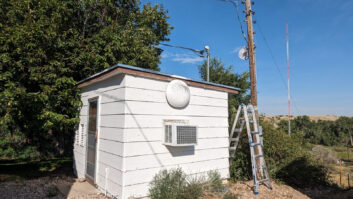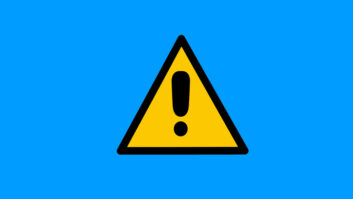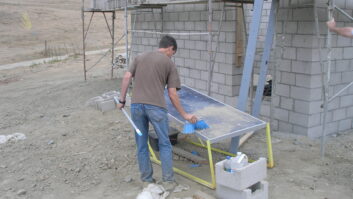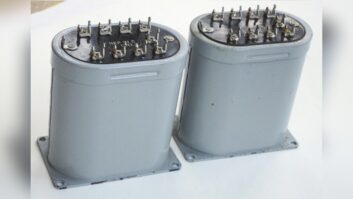(click thumbnail)KKOL’s new $2 million transmitter plant near the Port of Tacoma during program testing last September.For Salem Communications’ KKOL(AM) in Seattle, last fall’s sign-on of a new 50 kW transmitter plant near the Port of Tacoma was supposed to be the end of an odyssey during which the station operated from a ship while it searched for a new site.
Instead, the talk station has found itself at the center of a fight that pits its license to transmit against safety concerns at a nearby oil refinery, leaving the station at reduced power while it tries to protect the $2 million investment it made in the new transmitter site.
On the waterfront
The KKOL story began in 2001, when the station lost its longtime tower site at the Port of Seattle to a port expansion plan there.
To keep the station broadcasting while a new site was built, local engineer Jim Dalke built a temporary 1 kW facility using a Valcom antenna mounted on an old freighter docked in Elliot Bay (RW, Dec, 18, 2002).
That “temporary” facility ended up being used for almost five years as Salem searched for a workable new home for KKOL. In the end, the station found a site on the Tacoma waterfront with a water path to Seattle, where it built four new towers and a 50 kW transmitter plant.
Testing of the new facility began in the fall of 2006, and the signal (with 50 kW day and 47 kW at night) was licensed in January of this year — and with that, the station’s search for a permanent home should have been over.
On March 1, one of the new site’s neighbors, U.S. Oil & Refining Co., filed a Petition for Reconsideration asking the FCC to rescind KKOL’s license to cover, kicking off what’s fast becoming one of the most unusual NIMBY cases in the world of AM transmitter facilities.
The U.S. Oil complaint claims that the KKOL daytime signal was strong enough at U.S. Oil’s offloading facility, about half a mile away, to draw arcs as workers unloaded crude oil from tankers, as well as interfering with sensors at the refinery and with the refinery’s phone system.
In subsequent filings, U.S. Oil, working with the Seattle consulting firm of Hatfield & Dawson, expanded on its concerns about the strength of the KKOL signal, raising the possibility that the RF from KKOL could be strong enough at the docks to cause a spark that would ignite fuel vapors or the fuel itself being unloaded.
Since the refinery provides fuel to nearby McChord Air Force Base, U.S. Oil also raised the specter that if suppliers refused to deliver fuel to its docks, the flow of fuel to the base might be cut off.
U.S. Oil declined Radio World’s request for an interview. Hatfield & Dawson principal Benjamin Dawson said the FCC filings spoke for themselves, noting only that “there have been instances where AM stations have had conditions on their licenses with regard to port facilities.”
As an interim measure, Salem first offered to switch KKOL to its night pattern (which directs less RF energy at the U.S. Oil docks) whenever a tanker was being offloaded, then began operating KKOL on the night pattern with 25 kW during daytime hours at the FCC’s request.
Dennis Ciapura, Salem’s senior vice president for broadcast development, says that temporary solution costs KKOL more than 700,000 potential listeners who fall outside the station’s 2 mV/m contour under the night pattern.
“The station was licensed by the FCC, and was in operation” before the U.S. Oil complaints began, Ciapura said.
“Our policy is, we fix everything at no cost to the neighbors,” Ciapura told Radio World. “We offered to send a team of engineers to survey their whole refinery and fix any grounding issues.”
‘Stop-gap’
As an initial step, the refinery rented an on-shore crane and nylon strapping to offload fuel from incoming freighters, in an attempt to prevent the completion of a circuit that could cause a spark.
“This stop-gap measure is not an acceptable solution,” U.S. Oil told the FCC, “… because U.S. Oil cannot eliminate the ignition source created by KKOL(AM) over the dock and refinery.”
Salem has enlisted its own experts to refute U.S. Oil’s claims of an ignition danger. Ciapura says their conclusion is that KKOL’s operation poses no threat to the refinery’s operations.
“There has never been a case of a radio station causing an explosion at a refinery, ever,” Ciapura says.
A declaration filed with the FCC by Dr. Vytenis Babrauskas concurs.
“There are thousands of high-power transmitters operating around the world, and many of them are in industrial zones which include chemical, petrochemical plants, military facilities and similar installations,” Babrauskas wrote. “Because of this huge profusion of transmitter installations, were there to be an identifiably non-zero risk of such ignitions, such accidents would be regularly reported in the literature. Yet, there is no record of an explosion that would have ever originated from such capture of RF energy.”
Babrauskas says the onus is on U.S. Oil to control any potential release of flammable vapors. And Ciapura says any vapor cloud concentrated enough to pose an ignition hazard would be dangerous in its own right to anyone on or near the docks, even if it did not ignite.
“They don’t shut the refinery down when there’s static overhead,” Ciapura says, noting that U.S. Oil’s petition to the FCC indicates that the plant operates 24/7, 365 days a year, which would include thunderstorms.
“If they don’t control their vapors, they represent a huge danger to their workers and the public,” Ciapura said.
Representatives of Salem and U.S. Oil met with the FCC’s Media Bureau staff on April 7, and Ciapura says the commission was sympathetic.
“I think the FCC would be concerned that a licensed broadcast facility is under attack,” Ciapura said.
He says there are other extraordinary circumstances playing out in the KKOL fight.
“I was shocked to find Hatfield & Dawson, who have represented broadcasters for years, taking the oil company’s case,” Ciapura said
There’s no retreating to the “temporary” shipboard facility, either. Dalke, who installed KKOL’s floating transmitter site, says the antenna and transmitter have been dismantled and the freighter is now moored at a different Seattle location. Dalke worked with Salem on the 2001–02 installation, he’s now assisting with the U.S. Oil case against KKOL. He has been chronicling the case in reports for the Seattle SBE Chapter 16 newsletter, The Waveguide.
While awaiting an FCC ruling on U.S. Oil’s petition, all sides agree on one thing: They’re in the midst of one of the most unusual interference complaints anyone in the AM radio field can recall.
“I’ve never seen anything like it,” Ciapura said. “We’ve always been able to solve a problem.”








